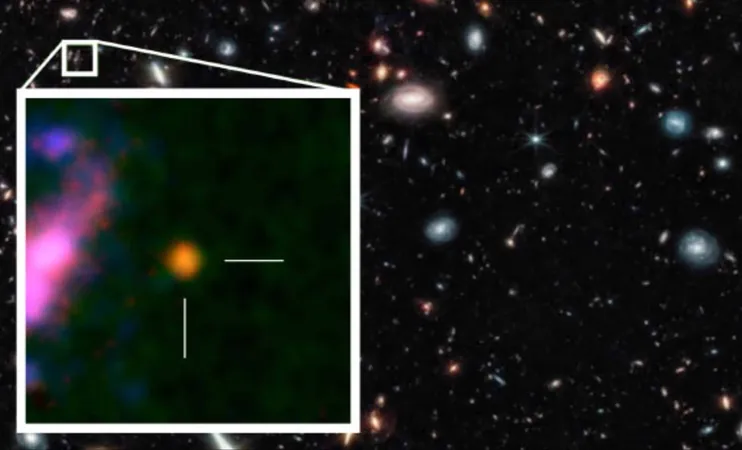
Astronomers Uncover Oxygen in the Universe's Most Distant Galaxy Yet!
2025-05-16
Author: Chun
A Groundbreaking Cosmic Discovery
In an astonishing feat, scientists have discovered oxygen in a galaxy so remote that its light has traveled an incredible 13.4 billion years to reach Earth. This monumental find provides a rare glimpse into the universe’s early days, just a few hundred million years after the Big Bang, as reported in the latest research published in Nature Astronomy.
The Power of Innovation: ALMA and JWST Team Up
The extraordinary detection of oxygen in the galaxy GHZ2 was made possible through the innovative collaboration between the Atacama Large Millimeter/submillimeter Array (ALMA) and the James Webb Space Telescope (JWST). Jorge Zavala, an astronomer involved with the study, explained the daunting observational challenge: "We aimed over forty ALMA antennas and the 6.5-meter JWST for hours at a patch of sky that seemed completely barren to the naked eye." This powerful duo allowed researchers to detect faint emissions from excited atoms, unveiling the elemental composition and stellar activity within the galaxy, marking a significant milestone in multi-wavelength astronomy.
GHZ2: A Cosmic Mystery with Intense Star Activity
GHZ2 is a compact star-forming galaxy, harboring a mass equivalent to a few hundred million suns within a span of just a few hundred light-years. This unprecedented density raises intriguing questions about the formation of such concentrated structures in the universe’s infancy. Notably, the galaxy’s metallicity—concentration of elements heavier than hydrogen and helium—stands at approximately one-tenth of that near our Sun, underlining the youthful nature of this cosmic environment. These metals, including oxygen, come from vibrant, short-lived stars that ionize the surrounding gas, indicating a rapid cycle of star birth that is far outpacing the slower formation rates typical in mature galaxies.
Clues to Cosmic Evolution and Globular Clusters
The distinct characteristics of GHZ2 might unlock secrets about globular clusters—ancient, tightly packed stellar groups like those found in the Milky Way. Researchers have noted similarities between GHZ2's elemental patterns and stellar densities and those of long-lived globular clusters. Figuring out whether such primordial galaxies acted as the seeds for these structures could illuminate a significant mystery in the cosmos. Astrophysicist Tom Bakx from Chalmers University heralded this discovery as a pinnacle of research into early galaxies, emphasizing that more telescope time will be crucial for unraveling the intertwined evolution of metals, star formation, and black holes in the youthful universe.
What Lies Ahead?
Future observations are set to delve deeper into GHZ2's structure and chemical makeup, promising to further clarify the processes that have sculpted our universe’s early history. Stay tuned as we continue to uncover the breathtaking secrets of the cosmos!



 Brasil (PT)
Brasil (PT)
 Canada (EN)
Canada (EN)
 Chile (ES)
Chile (ES)
 Česko (CS)
Česko (CS)
 대한민국 (KO)
대한민국 (KO)
 España (ES)
España (ES)
 France (FR)
France (FR)
 Hong Kong (EN)
Hong Kong (EN)
 Italia (IT)
Italia (IT)
 日本 (JA)
日本 (JA)
 Magyarország (HU)
Magyarország (HU)
 Norge (NO)
Norge (NO)
 Polska (PL)
Polska (PL)
 Schweiz (DE)
Schweiz (DE)
 Singapore (EN)
Singapore (EN)
 Sverige (SV)
Sverige (SV)
 Suomi (FI)
Suomi (FI)
 Türkiye (TR)
Türkiye (TR)
 الإمارات العربية المتحدة (AR)
الإمارات العربية المتحدة (AR)